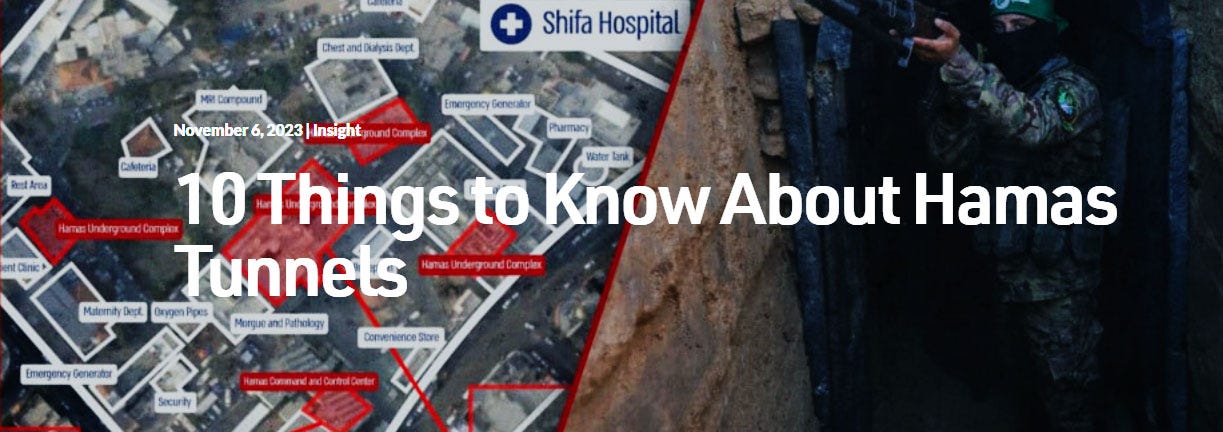10 Things to Know About Hamas Tunnels
The terrorist organization Hamas operates an extensive and sophisticated tunnel system to transport weapons, store supplies, and train operatives.
STAFF - NOV 6, 2023
The terrorist organization Hamas operates an extensive and sophisticated tunnel system to transport weapons, store supplies, and train operatives. The network zigzags for hundreds of miles under the Gaza Strip and across the Egyptian and Israeli borders. Tunnels can run up to 230 feet deep, about the height of a 20-story building. Iran-backed Hamas used tunnels to infiltrate Israel during previous conflicts in 2006 and 2014.
1. Hamas tunnels span hundreds of miles in Gaza
The Israel Defense Forces (IDF) reportedly destroyed over 60 miles of Hamas’s tunnel network during the May 2021 Gaza war. After the war, Hamas leader Yahya Sinwar said that Hamas possesses over 300 miles of tunnels and that Israel had “only destroyed 20 percent.” Israel often refers to the network as the Gaza “metro.”
2. Hostages are believed to be held in Gaza tunnels
Hamas spokesperson Abu Obeida claims that the group is holding hostages in “safe places and the tunnels of resistance.” On October 24, a freed Israeli hostage recounted her experience in captivity, explaining that she was taken through a network of tunnels akin to a “spider web.” The terrorists led the hostages to a “large hall” and then separated them into smaller groups.
3. Hamas tunnels played a central role in the 2014 Gaza war
Israel launched Operation Protective Edge on July 7, 2014, in response to repeated rocket fire from Gaza into southern Israel. On July 17, thirteen Hamas terrorists infiltrated Israel through the cross-border tunnels, violating a humanitarian truce. The IDF launched a ground operation that night “to target Hamas’ tunnels that cross under the Israel-Gaza border,” according to the IDF. By the end of the operation, the IDF had destroyed 32 tunnels. Israel proceeded to build a 40-mile above and below ground barrier, which it completed in 2021. The barrier includes cameras, radars, and sensors, and was designed to cut off Hamas’s ability to invade Israel using its underground network.
4. Hamas tunnels are equipped with advanced technologies
Hamas tunnels are outfitted with telephone lines, electricity, and railways. Hamas terrorists reportedly planned the October 7, 2023, attack over two years, using landlines installed in the tunnels to communicate. According to IDF estimates, each tunnel costs $3 million to build.
5. Hamas builds tunnels underneath hospitals, violating international law
On October 27, 2023, Israeli military spokesman Rear Admiral Daniel Hagari shared evidence of Hamas hiding tunnel entry points inside Gaza hospitals. Notably, Hamas also operates a large military complex underneath Shifa hospital, the largest hospital in Gaza. International law prohibits such use of hospitals for military purposes. A 1977 protocol to the Geneva Conventions makes clear that “under no circumstances shall medical units be used in an attempt to shield military objectives from attack.”
6. Hamas operates cross-border tunnels into Egypt to smuggle weapons and personnel
The IDF confirmed on October 26, 2023, that Hamas used tunnels under the Egyptian border to smuggle weapons and ammunition into Gaza before invading Israel on October 7. The terrorists could potentially flee to Egypt using the same underground network. Historically, smugglers have leveraged the tunnels between Egypt and Gaza to transport drugs, money, and other goods into the Gaza Strip. Hamas profits from the illicit trade by taxing commercial activity through the underground network.
7. The Egyptian government has shut down numerous tunnels into Gaza
Former Egyptian President Mohamed Morsi, an Islamist affiliated with the Muslim Brotherhood, tacitly allowed Hamas and Palestinian Islamic Jihad to transport missiles and other weapons using the cross-border tunnel system. Cairo started to crack down on the underground network after current President Abdel Fattah al-Sisi took power in 2013. To date, the Egyptian military has destroyed numerous tunnels using a variety of tactics, including flooding them with sewage. Nevertheless, Cairo has yet to completely shut down cross-border tunnel operations.
8. Hamas operates cross-border tunnels into Israel
The most well-known case of Hamas using the tunnel system to breach Israel’s border took place during the 2006 kidnapping of Israeli soldier Gilad Shalit. Israel exchanged 1,027 Palestinian security prisoners for Shalit in 2011. Hamas does not appear to have used tunnels to enter Israel on October 7. However, they remain a tactical option as evidenced by Hamas releasing footage on October 14 showing terrorists emerging from tunnels, simulating an attack on Israeli tanks, and returning underground.
9. Hamas diverts resources to construct terror tunnels
Hamas diverts concrete and other materials meant for civilian projects to build and reinforce its tunnel system. Former Israeli National Security Advisor Maj. Gen. Yaakov Amidror explained in 2014 that “when you look at what Hamas did with all the cement and the materials that went into Gaza for ‘building,’ and you see that most went on the tunnels, you understand that from their point of view the civilian side is not important.”
10. Hamas used child laborers to build its tunnel network
A report published in 2012 noted that as many as 160 children had died working in Hamas’s tunnel network. In a documentary produced that year, a youth laborer , “It’s a really dangerous job. We call it ‘graveyard of the living.’”
https://www.fdd.org/analysis/2023/11/06/10-things-to-know-about-hamas-tunnels/






